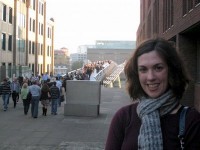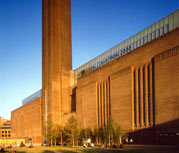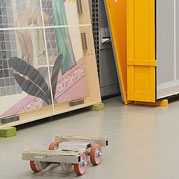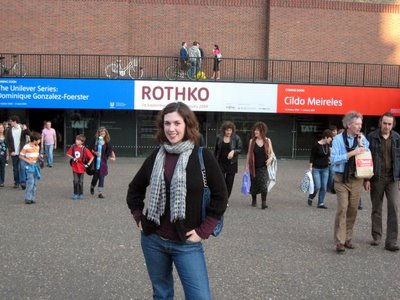I’ll admit it- I’ve always been a fan of contemporary art. This appreciation turned into a passion during my time working for the Walker Art Center in Minneapolis and I became a full-blown contemporary art junkie. Though I have since pursued a career in academia and world language education, the arts have always remained part of my personal and profession (writing) life. In the fall of 2008, the magazine I worked for asked me to write a review of  artist Latifa Echkach’s installation entitled Speaker’s Corner that was on view at the Tate Modern at the time. I jumped at the chance (and jumped on a plane) and found myself strolling along the banks of the Thames, approaching the imposing edifice of the Tate Modern.
artist Latifa Echkach’s installation entitled Speaker’s Corner that was on view at the Tate Modern at the time. I jumped at the chance (and jumped on a plane) and found myself strolling along the banks of the Thames, approaching the imposing edifice of the Tate Modern.
 Tate Modern is Britain’s national gallery of international modern art (it houses art since 1900). It is one of four Tate galleries found in England (Tate Britain, Tate Liverpool and Tate St. Ives), all of which display pieces from the vast Tate Collection of art from 1500 to the present. It was created in 2000 from an out of use power station in the heart of London. The power station was made up of a massive turbine hall (thirty-five meters high and 152 meters long), and the boiler house located next to it. In it’s present incarnation, the turbine hall serves as a dramatic entrance area (with naturally ramped wheelchair access) and as a display area for large-scale sculptural installations. The boiler house now serves as a series of galleries. These are located on three levels, and run the full length of the building; they are divided into a series of “suites,” to help facilitate your visit.
Tate Modern is Britain’s national gallery of international modern art (it houses art since 1900). It is one of four Tate galleries found in England (Tate Britain, Tate Liverpool and Tate St. Ives), all of which display pieces from the vast Tate Collection of art from 1500 to the present. It was created in 2000 from an out of use power station in the heart of London. The power station was made up of a massive turbine hall (thirty-five meters high and 152 meters long), and the boiler house located next to it. In it’s present incarnation, the turbine hall serves as a dramatic entrance area (with naturally ramped wheelchair access) and as a display area for large-scale sculptural installations. The boiler house now serves as a series of galleries. These are located on three levels, and run the full length of the building; they are divided into a series of “suites,” to help facilitate your visit.
 The exterior of the power station was left relatively untouched, with the exception of a two- story glass penthouse (referred to as the Lightbeam) by architects Herzog and De Meuron. The chimney is capped by a multicolored light apparatus, called the Swiss Light, designed by artist Michael Craig-Martin. Inside, on Level 7 of the Lightbeam, you’ll find the Tate Modern Restaurant, where you can enjoy a delicious, reasonably priced meal (with erudite wine pairings) while gazing out the expansive windows on one of the best views of London.
The exterior of the power station was left relatively untouched, with the exception of a two- story glass penthouse (referred to as the Lightbeam) by architects Herzog and De Meuron. The chimney is capped by a multicolored light apparatus, called the Swiss Light, designed by artist Michael Craig-Martin. Inside, on Level 7 of the Lightbeam, you’ll find the Tate Modern Restaurant, where you can enjoy a delicious, reasonably priced meal (with erudite wine pairings) while gazing out the expansive windows on one of the best views of London.
The most impressive aspect of the Tate to me was its pedagogical bent. The galleries are organized around “hubs,” or large central displays that explain movements such as Surrealism, Minimalism, Cubism, Futurism, and Vorticism. Around these hubs, you’ll find displays that move in chronological order (to better comprehend the evolution of movements). The first room in each wing features groupings of art from different generations that demonstrate ongoing dialogues in the artistic world. Visitor’s can also benefit from the Learning Zone, a hands-on, multimedia educational space and library.
 Unlike many other contemporary art museums I’ve visited, the Tate Modern is appealing even to those who may not prefer this style of art. The impressive architectural aspects of the building itself, park area around the museum, the view from Level 7, and first rate restaurants offer something for those who (gasp!) don’t really want to look at the art. And for those of us who already have an appreciation or passion for contemporary art, the Tate Modern is sure to exceed your expectations.
Unlike many other contemporary art museums I’ve visited, the Tate Modern is appealing even to those who may not prefer this style of art. The impressive architectural aspects of the building itself, park area around the museum, the view from Level 7, and first rate restaurants offer something for those who (gasp!) don’t really want to look at the art. And for those of us who already have an appreciation or passion for contemporary art, the Tate Modern is sure to exceed your expectations.
Tate Modern -International modern and contemporary art
Bankside
London SE1 9TG
Tel: 020 7887 8888
Entry is free except for major exhibitions
Open Sunday – Thursday, 10.00–18.00
Friday and Saturday, 10.00–22.00
Last admission into exhibitions 17.15 (Friday and Saturday 21.15)
Closed 24, 25 and 26 December (open as normal on 1 January).


Comments